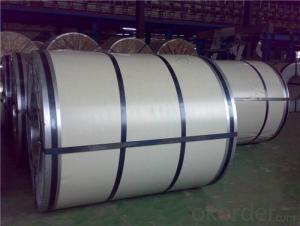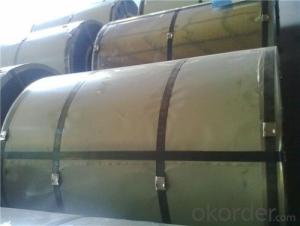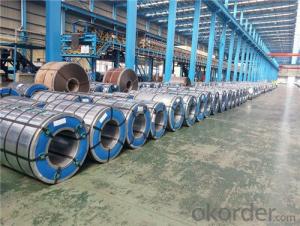BMT Prepainted Rolled Steel Coil for Construction
- Loading Port:
- Shanghai
- Payment Terms:
- TT OR LC
- Min Order Qty:
- 50 m.t.
- Supply Capability:
- 30000 m.t./month
OKorder Service Pledge
OKorder Financial Service
You Might Also Like
Structure of BMT Prepainted Rolled Steel Coil for Construction

Description of BMT Prepainted Rolled Steel Coil for Construction
BMT Prepainted Rolled Steel Coil is a kind of coated steel coil/sheet. With the cold rolled steel of different strength and thickness as substrate, it is produced through applying Zn coating on both faces by hot dip process. Its surface has bright silver color and regular embossed-like figure, which are highly decorative.

Main Feature of BMT Prepainted Rolled Steel Coil for Construction
1.Corrosion resistance: It mainly depends on the aluminum protection. When the zinc being worn, the aluminum will form a dense layer of aluminum oxide, resist corrosion material to prevent further corrosion inside.
2. Heat reflective: Galvanized steel plate heat-reflective high rate is twice as galvanized steel, often used to make insulation materials.
3. Economy: Because density of 55% AL-Zn is smaller than the density of Zn, so in the same weight and thickness of Galvanized zinc layer, aluminum-zinc steel plate is larger area more than 3% of galvanized steel sheet.
Applications of BMT Prepainted Rolled Steel Coil for Construction
1. Construction and building: roofing; ventilating duct; handrail; partition panel
2. Electric appliance: refrigerator; washing machine; refrigerator..
3. Transportation: oil tank; road sign; etc.
4.Agriculture:barn; etc.
5. Others: vending machine; game machine; etc.
Specifications of BMT Prepainted Rolled Steel Coil for Construction
Product | BMT Prepainted Rolled Steel Coil for Construction |
Material Grade | SGCC / SGCH / DX51D+AZ, etc |
Thickness | 0.2-3.5mm |
Width | 600-1250mm |
Tolerance | Thickness: +/-0.02mm , Width:+/-2mm |
Zinc-coating | Z40-150g/m2 |
Technique | Raw material: Hot rolled steel coil --> Cold rolled_>hot dipped galvalume |
Surface | Dried, Chromated, Unoiled |
Spangle | Regular spangle , small spangle, zero spangle |
ID | 508MM |
Coil weight | 25MT max |
Export package | Cardboard inner sleeves, Waterproof paper, galvanized steel covered and steel strip packed |
FAQ of BMT Prepainted Rolled Steel Coil for Construction
We have organized several common questions for our clients,may help you sincerely:
1. What is your MOQ ?
Our MOQ is 50mt. And we could offer more discount if you order like 1000 tons and more. Furthermore, the more appropriate payment term your can offer, the better price we can provide.
2. How long can we receive the product after purchasing?
Usually it is within thirty working days after received buyer’s advance payment or LC. We will arrange the factory manufacturing as soon as possible. The cargo readiness usually takes 20- 25 days, but the shipment will depend on the vessel situation.
3. How do you guarantee the quality of the products?
We have established the international advanced quality management system ,every link from raw material to final product we have strict quality test;We resolutely put an end to unqualified products flowing into the market. At the same time, we will provide necessary follow-up service assurance.
4. What different between PVDF and PE?
PVDF is the most advanced painting in construction industry, it is with high corrosion resistance and color retention, and the life time could last to 20-25 years. Currently, PE is the most widely-used painting in the color coated steel coils. It is characterized by good overall performance, and high economic as well
- Q:What are the key factors affecting the strength of a steel coil?
- The key factors affecting the strength of a steel coil include the grade and composition of the steel used, the manufacturing process and techniques employed, as well as the heat treatment and cooling methods implemented. Other factors such as the thickness and width of the coil, as well as any mechanical or surface treatments applied, can also influence its strength.
- Q:Classify the following in as many ways as possible:stainless steelpureheterogeneous mixturehomogeneous mixturenone of these
- homogeneous mixture
- Q:What are the common coil surface finish standards?
- Some common coil surface finish standards include mill finish, brushed finish, polished finish, and coated finish.
- Q:What are the different coating options for steel coils?
- There are several coating options available for steel coils, each serving different purposes and providing unique benefits. Some of the commonly used coating options for steel coils include: 1. Galvanized Coating: This coating involves immersing the steel coils in a bath of molten zinc, creating a layer of zinc on the surface. Galvanized coating provides excellent corrosion resistance and protects the steel from rusting. It is commonly used in applications where the steel coils are exposed to harsh environments or moisture. 2. Galvannealed Coating: This coating is a combination of galvanizing and annealing processes. The steel coils are first galvanized and then annealed to create a layer of zinc-iron alloy on the surface. Galvannealed coating offers enhanced paintability and weldability while providing good corrosion resistance. 3. Aluminum-Zinc Alloy Coating: Also known as Galvalume, this coating consists of an aluminum-zinc alloy applied to the steel coils. It provides excellent corrosion resistance and heat reflectivity, making it suitable for various applications, including roofing, siding, and automotive parts. 4. Organic Coatings: These coatings are typically applied as a top layer over a base coat of galvanized or galvannealed coating. Organic coatings can be in the form of paints, lacquers, or powder coatings. They provide additional protection against corrosion, UV rays, and abrasion, while also enhancing the aesthetics of the steel coils. 5. Chromate Conversion Coating: This coating is primarily used as a pre-treatment before applying organic coatings. It helps improve adhesion between the steel surface and the organic coating, ensuring better corrosion resistance. The choice of coating depends on various factors such as the intended application, environmental conditions, desired appearance, and budget. Manufacturers and end-users should carefully consider these factors to select the most suitable coating option for their specific requirements.
- Q:Can steel coils be used in electrical applications?
- Certainly, electrical applications can make use of steel coils. In the realm of electrical circuits, steel coils often serve as magnetic cores in transformers and inductors, which are indispensable components. The steel employed in these coils typically consists of high-quality electrical steel, possessing distinct magnetic attributes, including low core losses and high permeability. These attributes empower the steel coils to efficiently transmit electrical energy between various circuit components. Furthermore, steel coils can also find utility in other electrical applications, such as the construction of electric motors and generators. Taking everything into account, steel coils are extensively employed in electrical applications due to their magnetic properties and their capacity to handle high currents and temperatures.
- Q:What is the role of steel coils in the automotive industry?
- Steel coils play a crucial role in the automotive industry as they are used to manufacture various components and parts of vehicles, including body panels, frames, chassis, and suspension systems. The high strength and durability of steel make it an ideal material for ensuring structural integrity and safety in automobiles. Additionally, steel coils offer cost-effectiveness, versatility, and the ability to withstand extreme conditions, making them an essential component in the production of cars and trucks.
- Q:What are the challenges in coil slitting?
- Coil slitting, a method used to divide large metal coils into narrower strips of desired widths, has its advantages in terms of efficiency and flexibility. However, it also comes with several challenges. One of the primary obstacles in coil slitting is the need to ensure consistent strip width accuracy. To achieve this, it is crucial to maintain uniform width measurements throughout the process. Any deviation in strip width can have downstream effects on the production line, impacting the quality and functionality of the final product. Overcoming this challenge requires the use of precise slitting equipment and careful monitoring of process parameters. Another challenge lies in managing the quality of the strip edges. The edges of the slit strips play a critical role, particularly in applications where they must be free from imperfections like burrs. Attaining clean and smooth edges necessitates proper blade selection, positioning, and maintenance. Any defects or irregularities on the strip edges can affect subsequent processes such as bending, welding, or coating. Additionally, the type of material being slit can pose challenges. Certain metals, such as high-strength steels or alloys, may be more difficult to cut due to their hardness or brittleness. Slitting these materials can result in blade wear and premature failure, leading to increased downtime and maintenance costs. Moreover, the presence of contaminants or surface defects on the coil can also impact the slitting process, requiring additional cleaning or preparation steps. Handling and processing large coils present another significant challenge. Coils can be cumbersome and heavy, necessitating proper equipment and procedures to ensure safe handling. Furthermore, the slitting process generates a significant amount of scrap material, which needs to be efficiently managed and disposed of. Proper storage, transportation, and recycling of the scrap are essential to minimize waste and maintain a clean and organized working environment. In conclusion, coil slitting offers benefits in terms of customization and productivity. However, it also poses challenges in maintaining strip width accuracy, managing edge quality, dealing with difficult materials, and handling large coils and scrap. Overcoming these challenges requires expertise, precision equipment, and careful process control to ensure the desired quality and efficiency in coil slitting operations.
- Q:What are the different types of steel processing techniques for coils?
- There are several types of steel processing techniques for coils, including hot rolling, cold rolling, annealing, pickling, and galvanizing.
- Q:What is stainless steel coil used for?
- Stainless steel coil is primarily used in various industries for its durability, corrosion resistance, and aesthetic appeal. One of the most common applications is in the manufacturing and construction sectors, where stainless steel coils are utilized to produce a wide range of products such as kitchen appliances, cutlery, automotive parts, and architectural structures. The corrosion-resistant properties of stainless steel make it an ideal choice for applications that require resistance to moisture, chemicals, and harsh environmental conditions. Additionally, the high strength and heat resistance of stainless steel coils make them suitable for use in industrial equipment, heat exchangers, and piping systems. Moreover, the aesthetic appeal of stainless steel, with its sleek and modern appearance, is often preferred in the design and production of consumer goods, including furniture, jewelry, and decorative items. Overall, stainless steel coil is a versatile material that finds extensive usage across various industries due to its excellent mechanical properties, resistance to corrosion, and aesthetic versatility.
- Q:Will hot dip galvanizing affect the properties of the steel
- depends on what your are dipping...i.e what its composition and properties were, was it a spring steel prior?
1. Manufacturer Overview |
|
|---|---|
| Location | |
| Year Established | |
| Annual Output Value | |
| Main Markets | |
| Company Certifications | |
2. Manufacturer Certificates |
|
|---|---|
| a) Certification Name | |
| Range | |
| Reference | |
| Validity Period | |
3. Manufacturer Capability |
|
|---|---|
| a)Trade Capacity | |
| Nearest Port | |
| Export Percentage | |
| No.of Employees in Trade Department | |
| Language Spoken: | |
| b)Factory Information | |
| Factory Size: | |
| No. of Production Lines | |
| Contract Manufacturing | |
| Product Price Range | |
Send your message to us
BMT Prepainted Rolled Steel Coil for Construction
- Loading Port:
- Shanghai
- Payment Terms:
- TT OR LC
- Min Order Qty:
- 50 m.t.
- Supply Capability:
- 30000 m.t./month
OKorder Service Pledge
OKorder Financial Service
Similar products
New products
Hot products
Related keywords






























